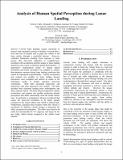| dc.contributor.author | Clark, Torin K. | |
| dc.contributor.author | Stimpson, Alexander James | |
| dc.contributor.author | Young, Laurence Retman | |
| dc.contributor.author | Oman, Charles M. | |
| dc.contributor.author | Duda, Kevin R. | |
| dc.date.accessioned | 2011-10-05T21:21:48Z | |
| dc.date.available | 2011-10-05T21:21:48Z | |
| dc.date.issued | 2010-03 | |
| dc.identifier.isbn | 978-1-4244-3887-7 | |
| dc.identifier.issn | 1095-323X | |
| dc.identifier.other | INSPEC Accession Number: 11258444 | |
| dc.identifier.uri | http://hdl.handle.net/1721.1/66194 | |
| dc.description.abstract | Crewed lunar landings require astronauts to interact with automated systems to identify a location that is level and free of hazards and to guide the vehicle to the lunar surface through a controlled descent. However, vestibular limitations resulting from exposure to lunar gravity after short-term adaptation to weightlessness, combined with acceleration profiles unique to lunar landing trajectories may result in astronaut spatial disorientation. A quantitative mathematical model of human spatial orientation previously developed was adopted to analyze disorientation concerns during lunar landing conditions that cannot be reproduced experimentally. Vehicle acceleration and rotation rate profiles of lunar landing descent trajectories were compiled and entered as inputs to the orientation model to predict astronaut perceived orientations. Both fully automated trajectories and trajectories with pilot interaction were studied. The latter included both simulated landing point redesignation and direct manual control. The lunar descent trajectories contain acceleration and rotation rate profiles producing attitude perceptions that differ substantially from the actual vehicle state. In particular, a somatogravic illusion is predicted that causes the perceived orientation to be nearly upright compared to the actual vehicle state which is pitched back. Furthermore, astronaut head location within the vehicle is considered for different vehicle designs to determine the effect on perceived orientation. The effect was found to be small, but measureable (0.3-4.1 degrees), and larger for the new Altair vehicle design compared to the Apollo Lunar Module. | en_US |
| dc.description.sponsorship | National Space Biomedical Research Institute | en_US |
| dc.description.sponsorship | United States. National Aeronautics and Space Administration (NASA NCC9-58-11, Project SA01604) | en_US |
| dc.language.iso | en_US | |
| dc.publisher | Institute of Electrical and Electronics Engineers | en_US |
| dc.relation.isversionof | http://dx.doi.org/10.1109/AERO.2010.5447026 | en_US |
| dc.rights | Article is made available in accordance with the publisher's policy and may be subject to US copyright law. Please refer to the publisher's site for terms of use. | en_US |
| dc.source | IEEE | en_US |
| dc.title | Analysis of human spatial perception during lunar landing | en_US |
| dc.type | Article | en_US |
| dc.identifier.citation | Clark, T.K. et al. “Analysis of human spatial perception during lunar landing.” Aerospace Conference, 2010 IEEE. 2010. 1-13. Copyright © 2010, IEEE | en_US |
| dc.contributor.department | Charles Stark Draper Laboratory | en_US |
| dc.contributor.department | Massachusetts Institute of Technology. Department of Aeronautics and Astronautics | en_US |
| dc.contributor.department | Massachusetts Institute of Technology. | en_US |
| dc.contributor.approver | Young, Laurence Retman | |
| dc.contributor.mitauthor | Clark, Torin K. | |
| dc.contributor.mitauthor | Stimpson, Alexander James | |
| dc.contributor.mitauthor | Young, Laurence Retman | |
| dc.contributor.mitauthor | Oman, Charles M. | |
| dc.contributor.mitauthor | Duda, Kevin R. | |
| dc.relation.journal | IEEE Aerospace Conference 2010 | en_US |
| dc.eprint.version | Final published version | en_US |
| dc.type.uri | http://purl.org/eprint/type/ConferencePaper | en_US |
| dspace.orderedauthors | Clark, Torin K.; Stimpson, Alexander J.; Young, Laurence R.; Oman, Charles M.; Duda, Kevin R. | en |
| dc.identifier.orcid | https://orcid.org/0000-0001-5732-4389 | |
| dc.identifier.orcid | https://orcid.org/0000-0002-9345-9712 | |
| dc.identifier.orcid | https://orcid.org/0000-0002-5576-3510 | |
| mit.license | PUBLISHER_POLICY | en_US |
| mit.metadata.status | Complete | |

